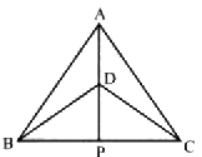If ab≥cd, then ad≤bc if b and d are of the same sign. Is it true?
The correct Answer is:No.
To solve the problem, we need to analyze the given inequality and the conditions provided.
1. Given Inequality:
We start with the inequality:
ab≥cd
2. Cross Multiplication:
Since b and d are of the same sign (both positive or both negative), we can cross-multiply without changing the direction of the inequality:
a⋅d≥b⋅c
3. Case 1: Both b and d are Positive:
If b>0 and d>0, the inequality remains:
ad≥bc
4. Case 2: Both b and d are Negative:
If b<0 and d<0, we can still cross-multiply, but we must remember that multiplying by negative numbers reverses the inequality:
a⋅d≤b⋅c
Rearranging gives:
ad≥bc
5. Conclusion:
In both cases (whether b and d are positive or negative), we find that:
ad≥bc
Thus, the statement ad≤bc is incorrect.
Final Answer:
The statement "If ab≥cd, then ad≤bc if b and d are of the same sign" is not true.
We start with the inequality:
ab≥cd
Since b and d are of the same sign (both positive or both negative), we can cross-multiply without changing the direction of the inequality:
a⋅d≥b⋅c
If b>0 and d>0, the inequality remains:
ad≥bc
If b<0 and d<0, we can still cross-multiply, but we must remember that multiplying by negative numbers reverses the inequality:
a⋅d≤b⋅c
Rearranging gives:
ad≥bc
In both cases (whether b and d are positive or negative), we find that:
ad≥bc
Thus, the statement ad≤bc is incorrect.
The statement "If ab≥cd, then ad≤bc if b and d are of the same sign" is not true.
Topper's Solved these Questions
- BOOK - MODERN PUBLICATIONCHAPTER - LINEAR INEQUATIONSEXERCISE - CHAPTER TEST12videos
LINEAR INEQUATIONS
- BOOK - MODERN PUBLICATIONCHAPTER - LINEAR INEQUATIONSEXERCISE - REVISION EXERCISE13videos
LINEAR INEQUATIONS
- BOOK - MODERN PUBLICATIONCHAPTER - LIMITS AND DERIVATIVESEXERCISE - CHECK YOUR UNDERSTANDING10videos
LIMITS AND DERIVATIVES
- BOOK - MODERN PUBLICATIONCHAPTER - MATHEMATICAL INDUCTIONEXERCISE - CHAPTER TEST 412videos
MATHEMATICAL INDUCTION
Similar Questions
Let C be the curve(s) given by (ax2+by2+c)(ay2−bx)=0; a,b,c∈R−{0} and a∈b. Then C represents (A) a parabola only if a, b and c are of the same sign. (B) a circle and a parabola if a and b are of the same sign and c is of opposite sign. (C) an ellipse and a parabola if a and b are of the same sign and c is of opposite sign. (D) a hyperbola and a parabola if ab<0
View SolutionIf bx+cy=a, there a,b,c are of the same sign, be a line such that the area enclosed by the line and the axes of reference is 18 square units, then : (A) b,a,c are in G.P. (B) b,2a,c arein G.P. (C) b,a2,c are in A.P. (D) b,−2a,c are in G.P.
View Solution
Knowledge Check
- Question 1 - Select One
If a+bb+c=c+dd+a, then
Aa must equal cBa+b+c+d must equal zeroCeither a=cora+b+c+d=0, or bothDa(b+c+d)=c(a+b+d) - Question 2 - Select One
If a,b,c and d are four real numbers of the same sign, then the value of ab+bc+cd+da lies in the interval
A[2,∞)B[3,∞)C(4,∞)D[4,∞)
If ab=cd , then (a+cb+d) is equal to
View SolutionABC and DBC are two isosceles triangles on the same base BC and vertices A and D are on the same side of BC . If AD is extended to intersect BC at P, show that ABD≅ACD (ii) ABP≅ACP AP bisects ∠A as well as ∠D AP is perpendicular bisector of BC.
 View Solution
View SolutionIf log2(a+b)+log2(c+d)≥4, then the minimum value of a+b+c+d is
View SolutionIf log2(a+b)+log2(c+d)≥4, then the minimum value of a+b+c+d is
View SolutionABC and DBC are two isosceles triangles on the same bas BC and vertices A and D are on the same side of BC . If AD is extended to intersect BC at P, show that ABD ≅ACD (ii) ABP ≅ACP
View SolutionIf log2(a+b)+log2(c+d)≥4, then the minimum value of a+b+c+d is
View Solution

